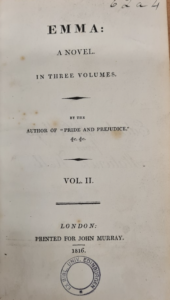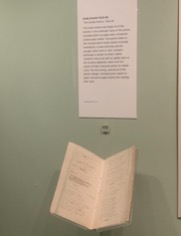Home University of Edinburgh Library Essentials
July 27, 2024
Seeing Scott through a Gendered Lens
Posted on July 29, 2021 | in Walter Scott 250 | by lbeattie‘Also read again, and for the third time at least, Miss Austen’s very finely written novel of Pride and Prejudice. That young lady had a talent for describing the involvement and feelings and characters of ordinary life which is to me the most wonderful I ever met with. The big Bow-wow strain I can do myself like any now going, but the exquisite touch which renders ordinary commonplace things and characters interesting from the truth of the description and the sentiment is denied to me. What a pity such a gifted creature died so early!’ Sir Walter Scott Journal entry, March 14th 1826
Walter Scott made his name through presenting daring battles and histories of old; bringing the past back to the present. Scott’s expert use, and even origination, of historical novel techniques still shape the genre today. However, Scott’s writing also presents unique and interesting female characters that can be deconstructed. These reveal subversive truths about the lives of Regency women, as well as how literary constructions attempted to present women’s idealised role within society. This blog post, we will explore three ways in which Scott’s works impacted female authors and how their role was shaped by their gender.
Two intriguing characters that Scott introduces are Minna and Brenda Troil in his 1822 Waverley novel The Pirate. Maggie’s role as a central character is heavily shaped by her gender. She departs from expectations of a social marriage and subverts expectations within the narrative. These sisters cope with being captured by pirates, as well as dealing with turbulent conditions at sea (and within their own personal lives). This story was then included by another great author, George Eliot, in her novel The Mill on the Floss (1860). Scott’s was also mentioned in Chapter 57 of one of Eliot’s most famous novels Middlemarch, which depicts the Garth children reading aloud from Scott, ‘that beloved writer who has made a chief part in the happiness of many young lives’. To Eliot’s heroine Maggie, Scott’s novels provide a sense of great comfort and companionship: ‘if she could have had all Scott’s novels and all Byron’s poems! – then, perhaps, she might have found happiness enough to dull her sensibility to her actual daily life.’ (Book 4, ch. 3). At one point, Maggie is offered The Pirate to read but refuses: ‘it would make me in love with this world again … it would make me long for a full life’. To Maggie, Scott’s heroines Minna and Brenda – as well their transformative love lives – provided a source of great longing and enjoyment. This reveals that Scott’s works did not just provide interesting and subversive heroines, but also that these heroines had a long-standing impact on some of Britain’s best female writers.
According to the British Library, Walter Scott was famed writer Emily Brontë’s ‘favourite author’. She heavily borrowed from his descriptions of the Scottish Highlands in ‘The Gondal Poems’ (1844-1848). Brontë imitated Scott’s vast and powerful descriptions, using them to build powerful images similar to her own native Yorkshire moors. This early poem in The Gondal series was written when she was just 18 years old, showing how important literary influence was in shaping her initial writing career. This highlights that Scott’s readership, as well as the content of his novels, helped to shape powerful women.
“Walter Scott has no business to write novels, especially good ones. – It is not fair.- He has Fame & Profit enough as a Poet, and should not be taking the bread out of other people’s mouths. – I do not like him, & do not mean to like Waverley if I can help it – but fear I must.”
Emily Brontë Display: British Library.
Perhaps, unusually, Scott remained a fierce devotee of Austen, despite her gender and untimely death. In 1816, Scott reviewed Austen’s longest novel Emma in the journal named Quarterly Review. He described the text as a “class of fictions which has arisen almost in our own times, and which draws the characters and incidents introduced more immediately from the current of ordinary life”. Scott recognises the incredible cultural narrative that Austen curated and was widely known as a fan throughout her literary career. Likewise, in 1826, Scott also lamented her death – acknowledging the strong contribution she made to literature. Thus, through Scott’s patronage and support, female authors also saw wider publicity than they otherwise might have done. This highlights that it is both his novels and his own role as a public author that acted as a way to shift gendered understandings during the period.

Emma First Edition.
This blog has been published in celebration of the university’s new Walter Scott 250 Exhibition, which celebrates the famed author’s relationship with contemporary and historical revolution.
Works Cited
Jane Austen Centre, Sir Walter Scott: Author and Critic, [https://janeausten.co.uk/blogs/authors-artists-vagrants/sir-walter-scott-author-critic]. Accessed 17/07/2021.
The British Library, The Pirate: novel by Walter Scott, [https://www.bl.uk/collection-items/the-pirate-novel-by-walter-scott]. Accessed 18/07/2021.
The British Library, Manuscript of Emily Brontë’s Gondal poetry [https://www.bl.uk/collection-items/manuscript-of-emily-bronts-gondal-poetry]. Accessed 16/07/2021.
Collections
 Archival Provenance Project: Emily’s finds
My name is Emily, and I’m the second of the two archive interns that...
Archival Provenance Project: Emily’s finds
My name is Emily, and I’m the second of the two archive interns that...
 Archival Provenance Project: a glimpse into the university’s history through some of its oldest manuscripts
My name is Madeleine Reynolds, a fourth year PhD candidate in History of Art....
Archival Provenance Project: a glimpse into the university’s history through some of its oldest manuscripts
My name is Madeleine Reynolds, a fourth year PhD candidate in History of Art....
Projects
 Sustainable Exhibition Making: Recyclable Book Cradles
In this post, our Technician, Robyn Rogers, discusses the recyclable book cradles she has developed...
Sustainable Exhibition Making: Recyclable Book Cradles
In this post, our Technician, Robyn Rogers, discusses the recyclable book cradles she has developed...
 Giving Decorated Paper a Home … Rehousing Books and Paper Bindings
In the first post of this two part series, our Collection Care Technician, Robyn Rogers,...
Giving Decorated Paper a Home … Rehousing Books and Paper Bindings
In the first post of this two part series, our Collection Care Technician, Robyn Rogers,...

